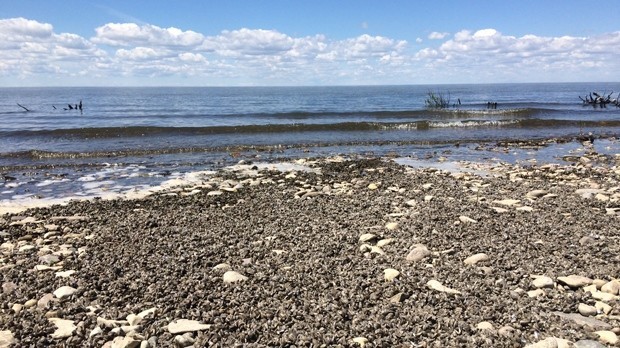アメリカの五大湖には、スペリオル湖を除いてZebra musselおよびQuagga musselと呼ばれる外来二枚貝2種が大量に繁殖して、下の写真のように大変なことになっています。

海のムラサキイガイに似たこの手の淡水性外来種として、日本でもカワヒバリガイが侵入しています。各地で農業用水の管などに付着して閉塞させる被害を出していますが、川岸や湖岸で上の写真のように一面に増えることはありません。日本だと鴨や鯉などが食べ尽くしてしまうからです。
五大湖の場合、貝を食べる鴨が渡ってくる頃には、既に氷が張っていて食べられる量は少ないそうです。
魚はどうでしょうか。
Wikipediaでは次のように説明しています。
Wikipedia Excerpt:
Predators[edit]
Research on natural enemies, both in Europe and North America, has focused on predators, particularly birds (36 species) and fish (15 and 38 species eating veligers and attached mussels).
The vast majority of the organisms that are natural enemies in Europe are not present in North America. Ecologically similar species do exist, but these species are unlikely to be able to eliminate those mussels already established and will have a limited role in their control.
五大湖はもともと二枚貝が少なく、ゆえに二枚貝を食べる魚も進化しなかったのでしょうか。
アメリカの知人に尋ねたら、下記の返事が届きました。オオユスリカがほぼ消えてしまった日本の平野の湖沼のように、五大湖でも私達の世代の間に本来いた動物がいつのまにか姿を消し、それもあって外来種が増えてしまったようです。
Sturgeon(チョウザメの仲間), which are stlll present but very scarce in the NAGL, feed on benthic organisms including mussels. There are ca. 50 species of *native* mussels in the NAGL, but many of these species face eminent extinction. So, today there are very few native mussels in the NAGL and even fewer sturgeon. The pelagic and benthic food webs of the NAGL have changed so dramatically during my lifetime that they are nearly unrecognizable today.